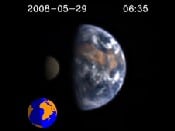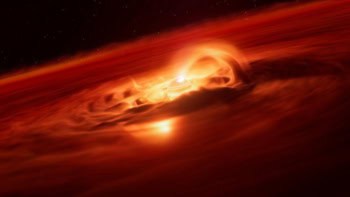
Scientists in the US have come up with a new method to search for oceans on “exoplanets” — planets outside our Solar System. The method, which involves studying how colours shift with an exoplanet’s rotation, could help in the quest for discovering extraterrestrial life.
There are several methods already used to spot water on exoplanets. One is spectroscopy, which can reveal the characteristic absorption wavelengths of water molecules and which has already been used successfully on giant planets. Others involve searching for the appearance of clouds or the glint of light shining off a reflective surface, although this latter technique has so far only been used for other liquids, such as methane on Saturn’s moon Titan.
Now Nick Cowan at the University of Washington in Seattle and others, including those on NASA’s EPOXI mission team, have designed a complementary method that should boost the chances of finding exoplanets with oceans — and, therefore, with life. “Since water is thought to be a prerequisite for life, we have effectively proposed another test for habitability,” Cowan told physicsworld.com.
Earth as an exoplanet
The researchers developed their method using data from Deep Impact, a NASA space probe that was launched in January 2005 to study the composition of a comet orbiting the Sun. Since Deep Impact completed this primary mission a few months later, it has been progressing on an extended mission called EPOXI to study another comet as well as distant exoplanets. During this extended mission, Cowan and colleagues have used the “high resolution imager” telescope on Deep Impact to examine Earth from a distance of a few tens of millions of miles, as though our planet were an exoplanet.
The overall colour of Earth is grey with some blue due to Rayleigh scattering of sunlight off the atmosphere. However, the researchers found that where the sky is clear — that is, with no clouds — the average colour changes with the Earth’s rotation: when the continents are in view, the colour shifts towards the red end of the spectrum; when the sea is in view, the colour shifts further into the blue. Such changes of colour should be able to reveal oceans on real exoplanets.
“The upshot [over the other methods] is that we don’t need very much spectral resolution — a few different filters would suffice — but we need pretty short exposures so that we can track time-variability,” says Cowan.
Bigger telescopes
However, Cowan adds that to see oceans on real Earth-sized exoplanets, which would be at least several light years away, astrophysicists would need a much larger telescope. This could come in the form of the proposed successor to the Hubble Space Telescope, called the Advanced Technology Large-Aperture Space Telescope, or ‘ATLAST‘, although it would need a device known as a coronagraph to block out the light from an exoplanet’s host star.
Still, it might be possible to see oceans on giant, “super Earth” planets when NASA’s forthcoming New Worlds observatory goes into orbit, perhaps by 2017. New Worlds will combine a large, 4 m diameter telescope with a very large coronagraph specifically for the detection of exoplanets.
Andreas Quirrenbach, an astronomer at the University of Heidelberg in Germany who is member of the US Exoplanet Task Force, thinks it might be a “matter of taste” whether this method would give proof of extra-solar oceans. “I myself would demand a higher standard, i.e. a spectrum, and I believe most astronomers would feel the same way,” he says.
But Quirrenbach adds that the method could serve either to give clues where watery planets exist, so that they can be followed up with spectroscopy, or simply complement spectroscopy to give more information. Over time, he says, the method could “develop into a tool to carry out a census of ocean-bearing planets around many stars, once we have convinced ourselves that the method is reliable by checking a fair number of cases spectroscopy.”
The research will appear in the August Edition of The Astrophysical Journal



